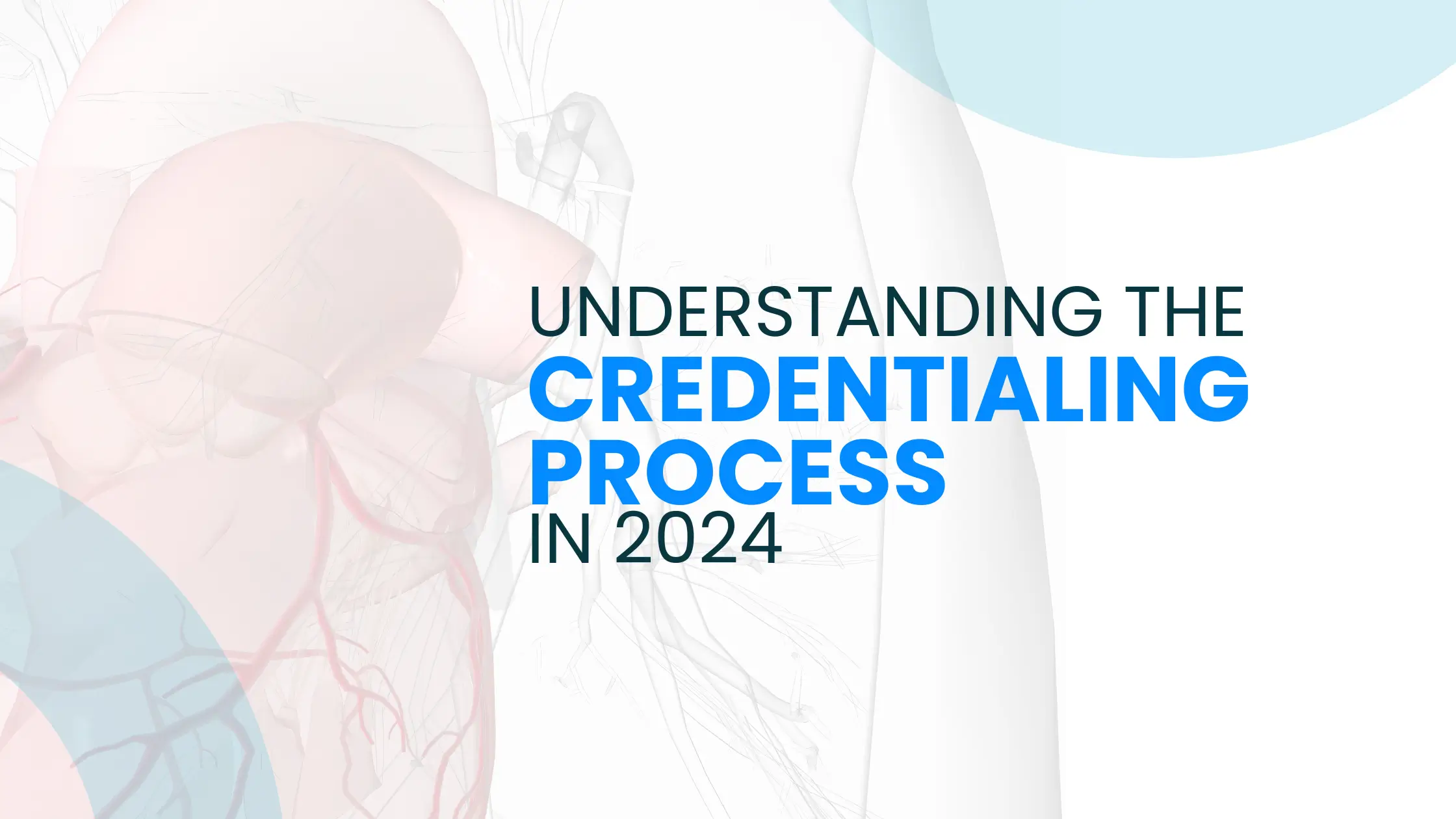Credentialing is a critical process in the healthcare industry that ensures healthcare providers meet the necessary qualifications and standards to deliver high-quality care. This process involves verifying a provider’s education, training, experience, and licensure to confirm they are competent and legally permitted to practice medicine within a specific scope and setting. Credentialing is vital for maintaining patient safety, upholding regulatory compliance, and enabling providers to participate in insurance networks. We have also covered insightful blogs for the process of credentialing verification and flow chart for provider credentialing, you may have a look.
Key Components of Credentialing
Credentialing involves several essential components to verify a healthcare provider’s qualifications thoroughly.

Educational Qualifications
Providers must hold a valid license to practice in the state where they intend to work. This involves providing a copy of the license and verification from the licensing board.
Licensure
Documentation of completed residency and fellowship training programs is required. This includes certificates of completion and verification from the training programs.
Residency and Fellowship Training
Healthcare providers, particularly physicians, must provide proof of their medical degree from an accredited institution. This includes transcripts, diplomas, and verification from the educational institution.
Board Certification
Board certification in a medical specialty is often required. Providers must provide proof of certification from a recognized medical board.
Professional References
References from colleagues, mentors, or supervisors who can attest to the provider’s qualifications and professional conduct are typically required.
Continuing Education
Proof of ongoing continuing education activities may be necessary to demonstrate the provider’s commitment to staying current with medical advancements and maintaining their skills.
Understanding the Credentialing Process
Credentialing is a multi-step process that involves several stages to ensure thorough verification of a provider’s qualifications.
Initial Application
The credentialing process begins with the provider completing a detailed application. This includes personal information, education history, training, work experience, and professional references. The application must be accurate and thorough to avoid delays.
Primary Source Verification
Once the application is submitted, the credentialing organization verifies the information with the primary sources. This involves contacting educational institutions, training programs, licensing boards, and previous employers to confirm the provider’s qualifications.
Background Checks
Comprehensive background checks are conducted to ensure the provider has no history of malpractice, criminal activity, or disciplinary actions. This step is crucial for maintaining the integrity of the healthcare system and ensuring patient safety.
Review by Credentialing Committee
The verified information is reviewed by a credentialing committee, which typically includes experienced healthcare professionals. They assess the provider’s qualifications and determine if they meet the organization’s standards.
Approval and Privileging
If the credentialing committee approves the provider, they are granted privileges to practice within the healthcare organization. Privileging defines the specific services the provider is authorized to perform based on their qualifications.
Re-Credentialing
Credentialing is not a one-time process. Providers must undergo re-credentialing periodically to ensure they continue to meet the necessary standards. This typically occurs every two to three years and involves updating the provider’s information and verifying any new qualifications or changes in their practice.
Common Errors in Credentialing and How to Avoid Them
Incomplete Applications
Incomplete applications can cause significant delays. Ensure all sections are filled out completely and accurately before submission.
Delayed Follow-Ups
Failing to follow up promptly with primary sources for verification can slow down the process. Regularly check the status of verifications and follow up as needed.
Lack of Documentation
Missing or outdated documentation can cause complications. Keep all credentials, licenses, and certifications up-to-date and readily available.
Credentialing and Re-Credentialing Timelines: What to Expect
Initial Credentialing
Initial credentialing can take several weeks to a few months, depending on the completeness of the application and the efficiency of the verification process.
Re-Credentialing
Re-credentialing typically occurs every two to three years and involves updating the provider’s information and verifying any new qualifications or changes in their practice. This process can take a few weeks to complete.
Credentialing for Different Types of Healthcare Providers
Physicians
Physicians undergo a rigorous credentialing process that includes verifying their medical degree, residency training, licensure, and board certification.
Nurses
Nurses must provide proof of their nursing degree, licensure, and any specialized certifications relevant to their field of practice.
Allied Health Professionals
Allied health professionals, such as physical therapists and occupational therapists, must provide documentation of their education, training, licensure, and certifications.
Best Practices for Efficient Credentialing
Use Credentialing Software
Investing in credentialing software can automate many aspects of the process, reducing manual work and minimizing errors. These tools can streamline application management, document verification, and communication with primary sources.
Maintain Accurate Records
Providers should keep comprehensive and up-to-date records of their education, training, and work history. Having these documents readily available can expedite the credentialing process.
Work with a Credentialing Service
Partnering with a professional credentialing service can alleviate much of the administrative burden. These services have expertise in navigating the complexities of the credentialing process and can ensure timely and accurate completion.
Stay Up-to-Date with Regulations
Healthcare regulations and credentialing standards are continually evolving. Staying current with these changes is essential for healthcare organizations and providers to maintain compliance and efficiency in the credentialing process.
Impact of Credentialing on Patient Care
Healthcare Credentialing is a crucial process that directly impacts patient safety and the quality of healthcare services. By verifying the qualifications and competence of healthcare providers, the credentialing process ensures that patients receive care from professionals who are capable and qualified to deliver the highest standards of treatment. This, in turn, reduces the risk of medical errors, improves patient outcomes, and enhances the overall trust in the healthcare system.
Future Trends in Credentialing
Blockchain Technology
Blockchain technology offers a secure and transparent way to manage credentialing data. It enables providers to maintain a verifiable and tamper-proof record of their qualifications and credentials, which can streamline the credentialing process and improve data integrity.
Artificial Intelligence and Machine Learning
Advancements in AI and machine learning can automate various aspects of the credentialing process, such as document verification, background checks, and decision-making. These technologies can significantly improve the efficiency, accuracy, and speed of credentialing.
Integrated Credentialing Systems
The integration of credentialing systems with electronic health records (EHRs) and other healthcare IT infrastructure can enhance the seamless flow of credentialing information. This can improve data accessibility, compliance monitoring, and overall efficiency in the credentialing process.
The Role of Credentialing in Risk Management
Credentialing plays a vital role in risk management by ensuring that healthcare providers meet the necessary qualifications and standards to deliver safe and effective care. Proper credentialing helps prevent medical errors, reduce liability, and maintain compliance with regulatory requirements, ultimately protecting both patients and healthcare organizations.
Conclusion
The credentialing process is a vital component of healthcare administration, ensuring that providers are qualified and capable of delivering high-quality care. By understanding the key components, best practices, and the impact of credentialing on patient care, healthcare organizations can enhance their credentialing practices and improve patient outcomes. As technology continues to evolve, the future of credentialing will likely involve innovative solutions that streamline the process and enhance data integrity, ultimately supporting the overall success of the healthcare system.
Frequently Asked Questions
Physician credentialing is the process of verifying a healthcare provider’s qualifications, including their education, training, experience, and licensure, to ensure they are competent and legally permitted to practice medicine. You should hire professional medical credentialing services providers for this.
Physician credentialing is the process of verifying a provider’s qualifications, while privileging is the process of granting a provider the specific clinical privileges or scope of practice within a healthcare organization based on their credentials and competence. You should read our informative blog on the same topic to have a clear idea about credentialing and privileging.
AMA credentials refer to the credentials issued by the American Medical Association (AMA), which is the largest association of physicians and medical students in the United States. AMA credentials include medical licenses, board certifications, and other professional designations.
Yes, credentialing is an integral part of the revenue cycle management (RCM) process in healthcare. Credentialing is necessary for providers to be able to bill and receive reimbursement from insurance companies and other payers.
An example of credentialing would be the process of verifying a physician’s medical degree, completion of residency training, and current state medical license to ensure they meet the requirements to practice medicine in a healthcare organization.


One thought on “Understanding the Credentialing Process: A Comprehensive Guide”